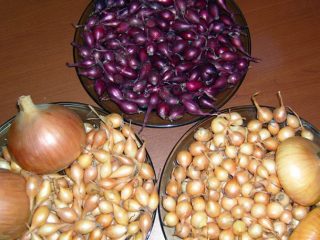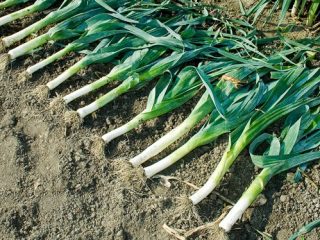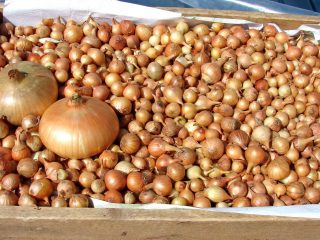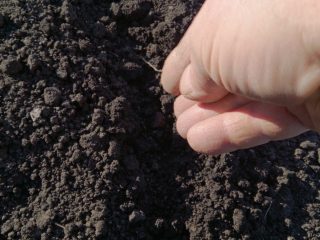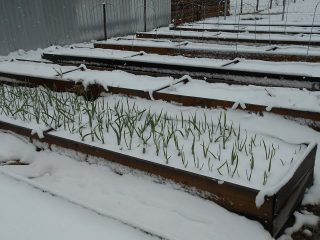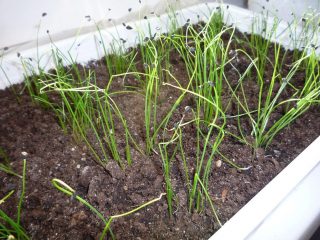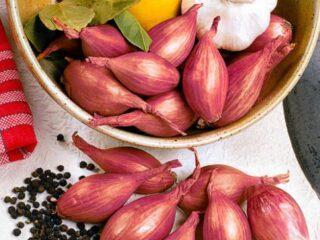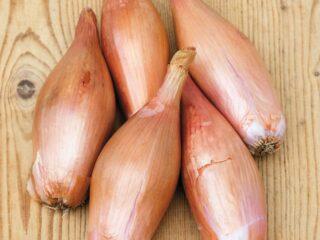Content
Helenas onion is a young hybrid variety with good yields and a pleasant taste. The crop can be easily grown in open ground, but before planting you need to study its characteristics.
Origin story
Helenas onion was developed in 2009 in the Netherlands. The originator is the well-known agrotechnical company Enza Zaden Beheer B.V. The plant is a first-generation hybrid and combines the best qualities of conventional varieties. The variety appeared in Russia in 2011. The variety is recommended for cultivation in the Lower Volga region, but in practice it is successfully cultivated in other regions of the country.
Description and characteristics of Helenas onion
Dutch onion Helenas is similar in appearance and characteristics to many other varieties of the crop. But it also has distinctive features that make the hybrid especially interesting.
Appearance
Helenas bulbs have a regular round shape.The outer scales of the fruit are thin and smooth, golden or bronze in color, and fit tightly to each other. The neck is medium in thickness; numerous thread-like roots up to 70 cm long extend from the bottom. Large bulbs can have up to 80 such shoots, while sets have an average of 35-60. The inner pulp of the fruit is white, dense, with a slight greenish tint.
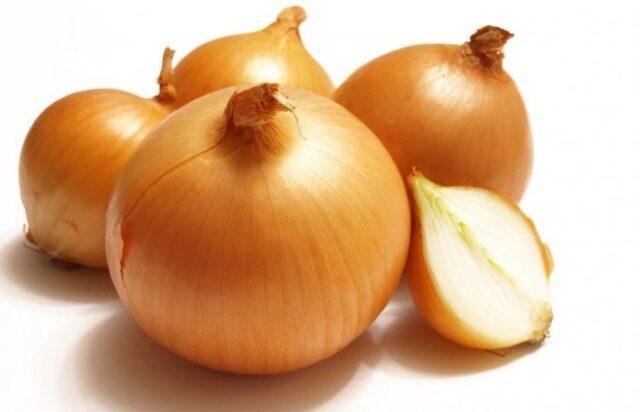
The average weight of Helenas onions is 100-60 g
The Helenas onion variety is grown not only for turnips, but also for feathers. The green leaves of the plant are tubular, moderately thick, hollow from the inside, with a thin layer of waxy coating on the surface. New feathers are produced weekly, so they can be cut for food continuously throughout the season. At the end of June, the onion sometimes produces a long arrow up to 1 m with a spherical inflorescence at the end, but it is better to remove it at the beginning of formation. Flowering negatively affects the quality of the crop, since the plant redirects all its energy to reproduction.
Ripening time and yield
Helenas onions take an average of 90-105 days to ripen. When planted in the ground in spring, the crop is fully ripened by the end of summer, and when planted in autumn, it gains succulence by mid-July.
Ripening is quite uniform - at the time of harvesting, about 90% of underground turnips are ready for consumption. Fruiting rates are quite high - from 1 m2 About 6 kg of onions are collected.
Disease resistance
Onion Helenas has good immunity to diseases and pests. Under good external conditions and proper care, it does not suffer from root rot, infections and insects. But at the same time, changes in temperature and humidity are dangerous for onions; they increase the vulnerability of the crop.
Composition and properties
The nutritional value of Helenas onion is determined by its chemical composition. The fruit pulp contains:
- ascorbic acid;
- iron and zinc;
- B vitamins;
- potassium;
- carotene;
- phytoncides and essential oils;
- vitamins A and PP;
- antioxidants and fiber.
When consumed in moderation, Helenas onion has a beneficial effect on the cardiac system and strengthens blood vessels, improves blood quality and prevents the development of anemia. It can be used in cases of slow metabolism and slagging in the body, inflammatory processes and infectious diseases.
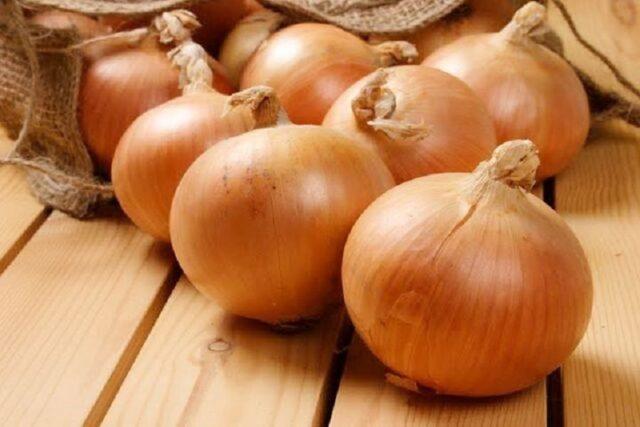
Onion Helenas can cause harm in gastrointestinal diseases in the acute phase and in hypertension
Application
The Helenas onion variety is a universal variety. Its green feathers are added to salads and snacks, and juicy turnips are eaten fresh in cold and hot dishes or boiled, stewed and baked. The bulbs have a characteristic pungent odor and a semi-sharp, pleasant taste.
Advantages and disadvantages
The Helenas variety has its strengths and weaknesses. Before planting Dutch onions on a plot, you need to objectively evaluate its characteristics.
Pros: · rapid early maturation; · large-fruited; · unpretentiousness to growing conditions; · simultaneous ripening; · high productivity; · good immunity to diseases and pests. | Minuses: · shelf life does not exceed six months; · reacts sensitively to temperature changes; · cannot be grown from your own seeds. |
The main disadvantage of the Helenas variety is that planting material must be purchased annually in the store.Seeds collected from onions by hand are not suitable for growing. When bred in this way, a hybrid variety partially or completely loses its unique characteristics.
Planting Helenas onions
There are several ways to grow Helenas onions on your property. To propagate the crop, use store-bought seeds or plant seedlings in the ground.
Growing from seeds
Helenas onions are planted with seeds through seedlings. In this case, it is possible to obtain a harvest within a standard time frame, even if spring comes quite late.
The seed sowing algorithm looks like this:
- A week before planting in mid-March, the material is soaked in a solution of potassium permanganate for a day, and then laid out on damp gauze and left in a warm and bright place for germination.
- A shallow but wide box is filled with a mixture of garden soil, compost, sand and peat, and then the substrate is spilled with a fungicidal solution.
- The seeds are slightly dried from moisture and buried into the soil 1 cm in rows at intervals of 5-6 cm.
- Sprinkle the planting material with soil and water it with a spray bottle.
Under the film, the container is placed in a warm place until the first shoots appear. After the seedlings have formed, the shelter is removed and the box is moved to a sunny windowsill in a room with a temperature of about 18 °C. Over the next two months, the seedlings are watered as the soil dries and complex mineral fertilizers are applied every two weeks, and in mid-May they are planted in the garden.

Between individual Helenas onion seedlings you need to leave 3 cm of space
Planting seedlings in spring
Another method suggests propagating Helenas onions on the site using sets. Planting can be done after the soil has thawed.Typically, suitable dates occur in early or mid-May, depending on the region.
The seed planting scheme is as follows:
- For the culture, choose a well-lit place with loose and nutritious slightly acidic soil.
- The soil is dug up and superphosphate, potassium salt and ammonium nitrate are added to it.
- Helenas onion sets are heated before planting for eight hours at a temperature of 40 ° C to eliminate possible fungi, and then cut off at the top by 1/3.
- Holes up to 4 cm deep are prepared on the site at intervals of 8 cm.
- Place a seed in each of the holes, placing it cut side up, and sprinkle with soil.
- Lightly compact the soil and water generously.
It is recommended to plant Helenas onions in rows, leaving a space of 20-25 cm between them.
Planting Helenas onions before winter
In the southern regions, Helenas onions are planted not only in spring, but also in autumn - at the end of October or beginning of November. The procedure as a whole is no different from the standard one:
- The sets are processed at 40 °C in the oven and trimmed in the neck area.
- The soil on the site is dug up and fertilized with complex minerals and organic matter.
- Planting material is sown in holes no more than 4 cm deep with small intervals.
- Sprinkle with soil and lightly compact.
The main feature of pre-winter planting is that Helenas onions are not watered, but immediately mulched with a dense layer of humus or compost. Otherwise, the crop may begin to grow, which should not be allowed before the onset of cold weather.

In autumn, Helenas onions are planted at air temperatures no higher than 5 °C.
Helenas onion care
When growing Helenas onions in the garden, you need to pay attention to several standard procedures:
- Watering.At the active growth stage, the culture is moistened twice a week, then as needed. A month before harvesting the turnips, watering is completely stopped so that the onions stop growing feathers.
- Feeding. For the first time, the crop is fertilized with a solution of bird droppings two weeks after the formation of seedlings. The second fertilizing is applied during the formation of the bulbs; potassium chloride and superphosphate are added to the soil.
- Loosening. After each watering, it is necessary to break up the dense crust that forms on the surface of the soil in the beds. In this case, the roots of the Helenas onion will be able to receive sufficient oxygen.
Conclusion
Helenas onions have low demands on external conditions and produce abundant harvests. The variety can be grown to produce turnips and green feathers - the plant is universal, all its parts have a pleasant taste and benefits.
Reviews from gardeners about Helenas onions
